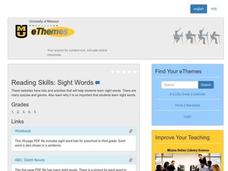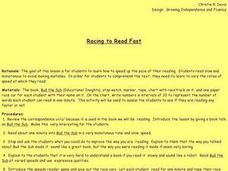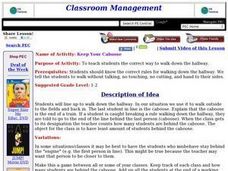Curated OER
My Favorite Papers
Students complete worksheets about themselves throughout the year. They are collected and kept by their teacher. They create a book at the end of the year with all of their writings.
Curated OER
Letter Chase
First graders are consonants or vowels. If a vowel is called out the vowels try to run to the base line and the consonants chase them and try to tag them. If a consonant is called out, the consonants run to their base line chased by the...
Curated OER
Author Study: Kevin Henkes
Learners use the Internet to access information about author Kevin Henkes and his many books. They read interviews, explore book-related mazes, recipes and activities and complete coloring pages, etc.
Curated OER
Sight Words
Students access a variety of sight word related resources on the Internet. They play concentration, read online books, play sight word bingo, and view various sight word lists and illustrations.
Curated OER
I Love to Eat Apples!
Learners study the a=/a/ correspondence by first examining how they hold their mouths when biting into an apple. They practice the sound while reciting a tongue twister and making a gesture each time they hear the /a/. While looking at...
Curated OER
Doc on Top
Students recognize the short /o/ sound in written and oral words in this lesson. They say a tongue twister which emphasizes words with the short /o/ sound. They then listen to the story "The Big Top" and identify the words in the story...
Curated OER
A-Okay
Students complete a variety of activities related to the long /a/ sound and the a_e vowel correspondence. As a class they recite a tongue twister, and spell words containing the /ae/ correspondence using letter manipulatives. Students...
Curated OER
Good Grape Soda--Gulp, Gulp, Gulp
Students recognize the phoneme /g/. Through matching activities, students discriminate the phoneme /g/ from other letters and phonemes. They associate the phoneme /g/ with its letter representation and identify the phoneme /g/ in various...
Curated OER
Big Pig
Students study the/i/ sound and letter recognition using Elkonin letterboxes and letter manipulatives. They work with tongue twister that contains words with many examples of the /i/ sound. Next they buddy read "Liz is Six" before...
Curated OER
Fun with Fish!
Students observe the phoneme and digraph /sh/ in spoken words. They discover a meaningful representation and practicie finding /sh/ in words. They read and spell words (using a letterbox lesson) that contain the phoneme /sh/.
Curated OER
Racing to Read Fast
Pupils identify and interpret how to speed up the pace of their reading. Then they read slow and monotonous to avoid making mistakes. Students also read to comprehend the text that they need to identify to vary the rates of speed at...
Curated OER
"Ehh?" Says Grandpa Edward"
Pupils engage in an emergent literacy lesson that focuses on phonemic awareness. This lesson plan helps students to identify the correspondence e=/e/ by recognizing the sound of an elderly person ¿¿¿eh?¿¿¿ throughout words.
Curated OER
Keep Your Caboose
Students identify the correct way to walk down the hallway, which means to walk without talking, no touching, no cutting, and hand to their sides. They line up to walk down the hallway and that the last student in line is the caboose,...
Curated OER
Spot the Differences
In this spot the difference worksheet, young scholars analyze pictures of two different wallabies to see if they can find six differences between the two.
Curated OER
Spot the Differences
In this spot the difference worksheet, students analyze pictures of two
different alligators to see if they can find six differences between the
two.
Curated OER
Spot the Differences
In this spot the difference worksheet, students analyze pictures of two
different water striders to see if they can find five differences between the
two.
Curated OER
Spot the Differences
In this spot the difference worksheet, students analyze pictures of two
different crabs to see if they can find five differences between the
two.
Curated OER
Spot the Differences
In this spot the difference worksheet, students analyze pictures of two
different green darners to see if they can find six differences between the
two.
Curated OER
Spot the Differences
In this spot the difference worksheet, students analyze pictures of two
different creeping thistles to see if they can find six differences between the
two.
Curated OER
Spot the Differences
In this spot the difference worksheet, students analyze pictures of two
different easter snake-necked turtles to see if they can find five differences between the
two.
Curated OER
Spot the Differences
In this spot the difference worksheet, students analyze pictures of two
different white-tailed deer to see if they can find six differences between the
two.
Curated OER
Spot the Differences
In this spot the difference worksheet, young scholars analyze pictures of two
different dinosaur scenes to see if they can find ten differences between the
two.
Curated OER
Spot the Differences
In this spot the difference worksheet, students analyze pictures of two
different bird images to see if they can find ten differences between the
two.
Other popular searches
- English Language Arts Games
- Word Games Language Arts
- Language Arts Games Clauses
- Language Arts Games 8
- Fun Language Arts Games
- Language Arts Games 8th
- Phonic Language Arts Games
- Language Arts Games Modals
- Games for Language Arts

























